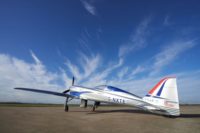LONDON—Rolls-Royce's all-electric "Spirit of Innovation" aircraft has set three world speed records. The state-of-the-at plane reached a top speed of 387.4 mph during runs conducted at the UK Ministry of Defense’s Boscombe Down experimental aircraft testing site.
The aircraft reached a top speed of 345.4 mph over a 3 kilometer course, smashing the existing record (set by the Siemens eAircraft powered Extra 330 LE Aerobatic aircraft in 2017) by 132mph. In further runs, the Rolls-Royce plane achieved 330 mph over 15 kilometers (182mph faster than the previous record) and broke the fastest time to climb 3,000 meters by 60 seconds, with a time of 202 seconds.
“The advanced battery and propulsion technology developed for this program has exciting applications for the Advanced Air Mobility market,” says Warren East, CEO of Rolls-Royce. “Never in the history of the FAI record attempts has there been such a significant increase in speed over such a short time, highlighting the rapid pace at which electrification of aerospace is advancing.”
The “Spirit of Innovation” was propelled on its record breaking runs by a 400kW (500+hp) electric power train and the most power-dense propulsion battery pack ever assembled in aerospace. We worked in partnership with aviation energy storage specialist Electroflight and automotive power train supplier YASA. As well as a stunning technical achievement, the project and world record runs provided important data for our future electric power and propulsion systems for all-electric urban air mobility and hybrid-electric commuter aircraft. The characteristics that air taxis require from batteries, for instance, are very similar to what was developed for the ‘Spirit of Innovation’.
“Electric flight is set to be as transformative for mobility as the jet engine was 70 years ago,” claims Tim Woolmer, Ph.D., chief technology officer at YASA. “It’s thrilling to see our ultra-high performance, super-low weight electric motors powering the ‘Spirit of Innovation’ to these great speeds, and to know that [this project] takes us one step closer to emissions-free electric flight becoming a commercial reality for all.”






